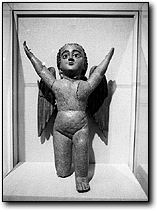![]()
![[ ARTS
]](/images/fall97/artsublogo.gif)
By Nate Byerley
Arizona Daily Wildcat April 30, 1998
Tucson Museum of Art highlights Spanish craft
![[Picture]](12_3_i.gif)
Ian Mayer Liliane McLaughlin of Glendale, Calif., takes in the art at the El Alma del Pueblo exhibit yesterday at the Tucson Museum of Art. This Spanish folk art exhibit will be in Tucson until August. |
There is perhaps no better way to evaluate cultural values than through
an investigation of the most basic cultural expression: art. But "art,"
as we have come to know it in this culture, seems hopelessly reserved for
a select few. This is not, however, how it has always been.
"El Alma del Pueblo: Spanish Folk Art and Its Transition in the Americas," the current exhibit at the Tucson Museum of Art, depicts the values of a culture in which art popped up in nearly everything: from 12-foot devotional statues to three-inch eating utensils.
Folk art might most easily be explained as a craft.. Inherent in the production of folk art is the understanding of a process: painting, wood working, metalsmithing or weaving. These skills were passed along as they were necessary in the production of items used daily by Spaniards.
Many of the items in this exhibit are utilitarian in nature, including furniture, textiles, ceremonial masks and paintings, votive offerings and jewelry. The themes depicted in these items are primarily religious or spiritual, but there are many items of a predominantly secular motif as well.
Cabezudos, or grotesque masks worn during festivals or processions, illustrate the importance of humor and entertainment in Spanish culture. Similarly, numerous prints of bullfights serve to document this historic and culturally significant pastime.
The religious paintings and sculptures dating from the seventeenth century exhibit characteristically large eyes, which speak of the role religion played in Spanish society. Large eyes were symbolic of "windows to the soul," and religion was the means by which this soul was saved.
One major intention of this exhibit is to document the incorporation and transition of Spanish folk art to South, Middle and North American artistic styles. One piece, a silver alloy miner's lamp, represents the synthesis of cultural traditions as expressed through art. The legend follows that in certain Bolivian mines, the Virgin Mary is worshipped only to a certain depth. Beyond that depth, the Andean earth goddess Pachamama is worshipped in Quechua rather than Spanish. The iconography on the metal lamp detailed this cultural synthesis.

Ian Mayer Angelito Con Brazos Abiertos' Cherub With Outstretched Arms is one of the works currently on display. |
A Mexican print titled "El Mundo Al Revés," or "The World in Reverse," is a series of small frames in which the social conventions of the world are turned around. In one frame, a sheep roasts a baby on a spit; in another, a chair is seated upon a man. In another frame, a rich man panhandles the poor and in another, the living (bearing the reaper's scythe) chase the dead. One can make a surplus of inferences about the cultural values depicted here, while the technique of humor and sarcasm, with a history in Spanish folk art, continues.
While "El Alma del Pueblo" successfully places Spanish folk art in a historical and cultural context, the transition to the Americas could be more developed. I would have been particularly happy to see this progression of folk art include local contemporary Mexican and Mexican-American folk art. The ability to see our own history as it is being recorded in the art of current artisans and craftspeople would make the previewing of the history of our ancestors in folk art all the more accessible.
"El Alma del Pueblo: Spanish Folk Art and Its Transition in the Americas" will run at the Tucson Museum of Art, located at 140 N. Main Ave., until Aug. 2, when it will move on to New York. This exhibit is running concurrently with "Point of Fracture: Voices of Heinous Crime Survivors."



